
Fashion Merchandising
by Jacque Crouse
It's about creating a lifestyle
Fashion merchandising may conjure up pictures of someone dressing a mannequin in a storefront window or a retailer artfully arranging jewelry to draw the customer’s eye.
In truth, it involves a much broader spectrum of merchandise, goods, and careers. It also has experts assessing trends and developing creative solutions to meet new and emerging lifestyle movements.
“Creativity is a mindset, a perspective. Innovation is creativity in action,” says Dr. Gwendolyn Hustvedt, professor and fashion merchandising program coordinator. “Fashion merchandising is specialized merchandising; it is about lifestyle. Creating a quality of life in a home requires artistic tools.”
Fashion merchandising is part of the School of Family and Consumer Sciences in the College of Applied Arts. There are currently some 385 fashion merchandising majors and 100 minors. Fashion merchandising majors are required to minor in business administration. Sewing classes were first offered in San Marcos in 1911, the fashion merchandising concentration started in 1972, and by 1982 it became a major at the university.
Bobbie Moore, senior lecturer, says it is not unusual for a student to complete an internship and get a job offer. “Our students are heavily recruited by top employers,” she says. “We have a Fashion Merchandising Forum each spring that brings many different career industries on campus to talk to our students. We invite students from local area high schools, too.” The forum has become a special regional event and hosts some 400 attendees each year.
Moore also oversees an internship program brimming with opportunities. “We have [students at] Target, J.C. Penney, Kohl’s, Academy, Nordstrom, Dillard’s, and many more,” she says. “Our students may go on to work in corporate offices in fashion merchandising, as business analysts in fashion, in store leadership, or they may decide to open their own business. There are so many options.”

A business analyst in fashion is different from those in other areas, Moore says. “They study fashion sales and trends, and that requires a deeper knowledge of fashion merchandising. They are coming up with different takes, meeting the needs of consumers in a new way. The fashion experience never holds still or stays the same. You must be creative to be successful.”
Beth Guastella (B.S. ’85) started her career working at Foley’s in an executive training program in Austin. A Distinguished Alumna, she rose through the ranks and was recruited by such fashion corporations as Laura Ashley, Hermès, Kate Spade, and Nike’s Cole Haan. She lives in New York and is the vice president and general manager for Jo Malone London, an Estée Lauder company. Guastella says with the emphasis on data, social media and digital platforms make it even easier to be creative.
“We used to talk about the Chicago customer, but with data, we find there are actually 13 distinct profiles of customers in Chicago,” she says. “We can do visual merchandising to fit customers, and social and digital media. You need to be more strategic and that means being more creative.”
Heather Frierson (B.S. ’99) founded the Created Woman foundation based on fashion and faith. The nonprofit teaches leadership and confidence by using fashion, whether it be a corporate executive, medical professional, or soccer mom. “We focus on both faith and fashion, and every month bring in speakers from both areas,” she says. “Using fashion as a reflection of yourself isn’t about vanity; it is about valuing who you are. Without this degree, I would not be doing the creative work I love.”
Austin influencer and designer Jessica Salazar (B.S. ’11) may opt for another creative path. Last year, she taught fashion design at Texas State and was an assistant women’s golf coach. Before that, Salazar earned a master’s in fashion entrepreneurship from the London College of Fashion, traveled to China, worked in Milan with a fashion designer, and lived in Paris.
“I decided last year I needed to fulfill my passion for ethical fashion,” Salazar says. Today, she focuses on women’s welfare and animal welfare, and leaving a lighter ecological footprint. She promotes ethical fashion brands, coordinates events dedicated to ethical lifestyles, and declutters spaces to encourage a more minimalist lifestyle. She is becoming recognized as an expert in her field and has begun to speak at conferences.
Hustvedt points out that, like architecture, fashion merchandising requires the successful meeting of creativity, design, and math. “If you don’t like math and do not want to use it, fashion merchandising probably isn’t the place for you,” she explains.
The new look of fashion merchandising is a world where graduates may work at a corporate level to create plans for many stores to follow. The work involves analyzing sales and style trends. Professionals are also affiliated with online merchandising because they can understand how style attributes like color work to create sales.
“One student just made a plan for a business that sells plants,” the professor says. “It is a lot more than clothing. It has to do with forecasting customer taste and lifestyle.”
That said, if you work in fashion merchandising, at some point you may have to work in a store, and both Hustvedt and Moore agree that Texas State students usually put in this part of career development while in school. “Our students are not afraid of hard work. They are used to solving challenging issues and have an amazing work ethic,” Hustvedt says. “You don’t join the army and expect to be a general in four years. Stores are the battlefields of the fashion industry. Our students get good experience at the outlets while they are in school.”
Sarah Hadley (B.S. ’11) attended the Fashion Merchandising Forum and later joined Academy Sports and Outdoors as an assistant buyer. The Houston resident has been there for more than seven years. She currently manages a team that includes an assistant buyer, a merchandise planner, and a replenishment analyst.
Hadley loves her work, especially the creative side, and says no two days are ever the same. “Buying is an art and a science. While the math and business acumen are critical to building and executing successful strategies, the buyer is a pivotal director of the products that come to the market,” she says. “The buyer has to understand what the customer wants and be able to apply trends, color direction, and mitigate risks with new ideas while applying logic and math to support the decisions.”
Hustvedt says the core of being successful in this field is a good work ethic and remembering that it is a myth that a beautiful fashion experience “just happens.” Those who create that experience know that it is put together through hard work and careful planning. “Fashion is the creating of a fantasy experience that others can enjoy, and you will have to get behind the scenes and know the nuts and bolts to create that experience for others,” the professor says.
Guastella says when she graduated in the mid-1980s, her brothers laughed at her degree in fashion merchandising, with one calling it “one step up from basket weaving.”
The tables have turned. “Now, I am the one laughing — literally all the way to the bank,” she says. ✪